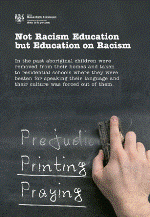2008: Celebrating the 60th Anniversary of the Universal Declaration of Human Rights
Universal Declaration of Human Rights: Introduction
Sixty years ago, nations of the world joined together in recognizing that all peoples, in all nations, are free and equal regardless of race, religion, economic status, age, gender or other personal characteristics. Through the signing of the Universal Declaration of Human Rights in 1948, the United Nations brought into being the first international document recognizing human rights as the foundation of peace, justice and freedom in the world.

The Universal Declaration outlines 30 basic rights essential for all human beings to achieve their full potential and to live a life free of fear and want. It was a unique approach that developed from the world saying 'never again' to the horrific events of World War Two, a war that brought a scale of atrocity never previously witnessed. The global death count is estimated to have been more than 50 million. War crimes were widespread: from the infamous Holocaust in which Nazi Germany sought to eliminate 'undesirables' such as Jews, Poles, Slavs, Roma, Sinti, the mentally and physically disabled, homosexuals and other persons, to the use of sex slaves, otherwise known as 'comfort women', by Japanese soldiers. Labour camps were used throughout the world and, disturbingly, World War Two brought the first testing of biological warfare by Japan and the use of atomic bombs in Nagasaki and Hiroshima by the United States of America. Read more...
The Right to Education

Access to education is a fundamental human right that has been enshrined within the Universal Declaration under Article 26, which states that education should be free and accessible to all. The international community has declared that both primary and secondary education are fundamental rights for children through the adoption of the Convention on the Rights of the Child in 1989. Furthermore, the international community has pledged a commitment to human rights and education through the Millennium Development Goals, Millennium Declaration and UNESCO Education for All initiative.
The importance of education for development is demonstrated by the gap between access to education in the developed world, where a standardized, institutionalized system has been established, and in less developed nations such as many in Africa where education is limited and is cost prohibitive. Education is a critical tool to lift children and families from poverty. Yet, in the least developed countries (LDCs), primary school attendance is as low as 55% for girls and 60% for boys, and 19% and 22% respectively for secondary school. Education is critical for long term development and capacity building in less developed countries. Yet according to UNESCO, there are currently 77 million children out of school.
Getting children into school is only the beginning. The struggle for education is also about creating the environment and conditions for effective learning. Often, as in developing countries, enhancing access and overcoming barriers to enrolment is just the tip of the iceberg. School systems in these countries struggle with a variety of challenges: a lack of teachers; children who come to school hungry or sick and sometimes traumatized by warfare; high student to teacher ratios; and, financial constraints.
In Canada, we are not free from barriers to education. Aboriginal students can face many challenges, including poverty, language barriers, geographical isolation and racism. Aboriginal children must often deal with stress outside the classroom, which makes it difficult for them to learn.
Some immigrants and refugees coming from countries of conflict or poverty have difficulty engaging in the school system. Placement by age further compounds their difficulties in Canada. Students from war-torn countries may not have been able to attend school in their home country, but as teenagers they may be placed in high school. These youth tend to come to Canada speaking English as a second language, making integration and learning more difficult. Teachers, often over-worked already, do not have the skills or capacities to effectively address this situation effectively on their own. Drop out rates for immigrant and Aboriginal youth are high, and have long term impacts on each individual as well as on the broader community. Inequality in education affects the employability of youth and their future quality of life.
Students with disabilities must deal with false stereotypes, negative attitudes and, frequently, inaccessible learning environments. To succeed at school, they require accommodation of their needs. They also need that most basic human right--the right to inclusion and to full participation in the community.
Another barrier in Canada's school system is the widespread incidence of bullying and discrimination. Students often experience sexual or other harassment. Youth who are from racialized backgrounds, have disabilities, or are gay or lesbian frequently face peer aggression. Youth and children who experience bullying often suffer from depression and lack of self-esteem, making the educational experience difficult. In a study in British Columbia, it was indicated that 72% of students witness bullying within their schools on an ongoing basis.
While you may not be able to have an impact on equal access to education for children around the world, you can make an impact here in Canada. Make it a point to get to know students from other countries, help them learn more about Canada, and be their friend. Say no to bullying or violence in the schools and make sure to speak out and say that it is not okay. One person's kind gesture in a new environment or in the face of bullying can make a big difference.
Learn More! Get Involved!
- Canadian Children's Rights Council
- CBC -- In Depth: Bullying
- UNESCO -- Education for All
- NetAid -- Access to Education
- CARE -- Basic and Girls' Education
- Global Campaign For Education
- Eldis -- Education for all
- Eldis -- School processes, local governance and community participation
- Eldis -- Universal basic and secondary education



